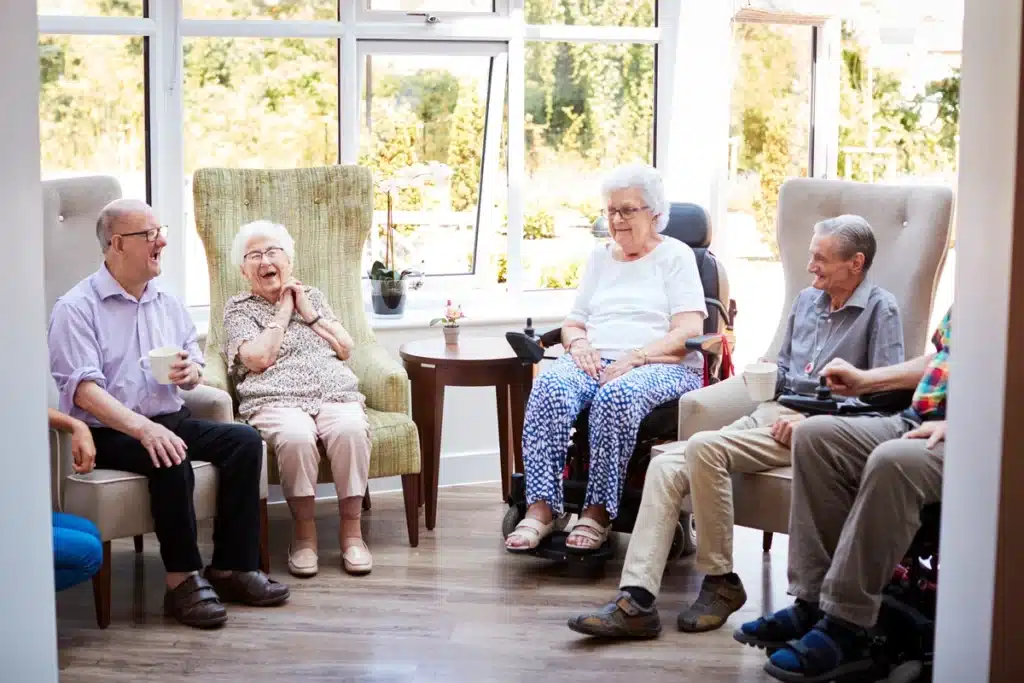More and more baby boomers are reaching and surpassing retirement age daily. This is creating a greater senior population compared to their parents’ time. Back then, there were very few senior living options, with family members being the primary choice for care.
Today, the landscape for senior living options looks much different. This is good news as not everyone ages the same way — and a greater senior population means a wider range of needs. What’s more, those needs will continue to change over time.
Below we’ll cover seven different senior living options. We’ll include who they’re best suited for, their benefits, and more to give you or your aging loved one a better idea of what’s out there so you can start planning accordingly.
1. Aging in Place
Aging in place is one of the many forms of independent living (and the most preferred). It refers to when an aging senior continues to live in their home versus moving into a retirement facility or one of the many senior living communities available to them.
In addition to remaining in the home, aging in place involves:
- Modifying the home to address any mobility issues
- Employing home health care professionals for assistance when needed
- Opting for programs like Meals on Wheels and other senior services if needed
Essentially, aging in place allows the individual in question to retain as much independence and “normalcy” as possible with limited assistance to help them get by.
🤷Who is Aging in Place For?
Aging in place is best suited for seniors who:
- Can handle most daily tasks on their own, such as bathing, getting dressed, cooking, etc.
- Already have a supportive community, such as friends, family, and neighbors in case issues arise
- Can afford a per diem, part-time, or full-time caregiver should they need further assistance
✅Benefits of Aging in Place
Aging in place is popular for several reasons, including:
- The ability to retain independence
- It’s often more cost-effective compared to an assisted living facility
- There are programs and services available to make it possible for individuals to stay in their homes for as long as possible
- It allows individuals to keep their beloved homes and often remain closer to family
💰Average Costs of Aging in Place
The costs of aging in place mainly revolve around modifying the home for potential mobility issues and hiring one or more professional caregivers if needed.
- Modifying the home can cost anywhere between $20,000 and $40,000. However, these modifications depend entirely on what your loved one needs — and they don’t have to happen all at once
- In-home care can cost an average of $4,576 per month. Of course, this depends on your location and the type of care needed
- Other costs include programs, services, regular bills, and other necessities that the individual may require
2. Age-Restricted Retirement Communities
Another type of independent living includes age-restricted communities. This option offers housing to seniors within a specific age range, usually 55 and up, and they may offer housing in the form of single-family homes, condos, townhouses, or apartments. Additionally, they can be rented or owned — it all depends on the community.
Age-restricted retirement communities typically cater to aging adults who have specific interests and prefer independent living so that individuals may choose their retirement community based on what they like to do and their preferred amenities.
These communities don’t typically offer assistance outside of basic services such as cleaning, laundry, and transportation.
🤷Who Are Age-Restricted Communities For?
Age-restricted retirement communities are best suited for:
- Older adults looking to downsize by selling their homes and moving into a community with people around the same age who have similar interests
- Older adults who don’t require assistance with daily tasks
✅Benefits of Age-Restricted Communities
- Individuals will easily make friends with others within their community
- Individuals who prefer independent living
- The homes and buildings are typically constructed with limited mobility in mind
- Home maintenance and lawn care are typically taken care of
- Individuals who own homes within these communities usually get to keep the financial and tax benefits associated with homeownership
💰Average Costs of Age-Restricted Communities
The cost of 55+ retirement communities depends on a variety of factors, including:
- The type and size of accommodations
- Location
- Available services
- Amenities
- Community or homeowners’ association fees
However, the price of renting or purchasing accommodations in one of these retirement communities is often more affordable compared to the typical market.
3. Assisted Living Communities
One of the most popular senior living options includes assisted living facilities (also referred to as an assisted living community or independent living community). Assisted living communities provide housing options that come with the necessary assistance regarding a senior’s activities of daily living (ADLs) — such as bathing, dressing, grooming, cooking, and so on.
Residents in an assisted living community will either have a private bedroom or a shared bedroom, depending on their preference, and are typically offered:
- Meals
- Cleaning services
- Laundry services
- Recreational and fitness programs
- Social events
- Transportation to doctor’s appointments, shopping, salons, entertainment, etc.
Some assisted living facilities offer skilled nursing care, but this is usually only to help with medication administration and emergencies.
🤷Who Are Assisted Living Facilities For?
An assisted living community is best suited for individuals who require help with basic activities on a daily basis, such as:
- Bathing and using the restroom
- Grooming
- Dressing
- Cooking or eating
- Doing laundry
✅The Benefits of Assisted Living Facilities
- Individuals receive professional help daily
- They’re regulated by state and local agencies to ensure the best possible care
- They promote as much independent living as possible
💰Average Cost of an Assisted Living Community
The national average to live in an assisted living community is about $4,000 monthly. However, state averages range from $3,000 to $10,000, with pricing depending on:
- Room size and type
- Amenities
- Level of care required
- Location
4. Nursing Homes
Nursing homes are senior living communities offering medical care and assistance at a higher level for older adults. Much like assisted living, nursing homes offer a number of amenities and social programs and provide ADL assistance.
They also provide medication management and skilled nursing care, as well as 24-hour supervision to ensure resident safety, health, and wellness.
🤷Who Is a Nursing Home For?
Aging adults who require regular medical assistance in addition to ADL assistance long-term are best suited for nursing homes.
✅Benefits of a Nursing Home
- They provide ongoing quality medical care to aging seniors with critical medical issues
- They’re licensed and regulated by state agencies to ensure appropriate medical care
- They provide plenty of programs and activities to help promote wellness and independence
💰Average Nursing Home Costs
The average cost of living in a nursing home ranges between $7,750 and $8,820 monthly. However, costs will vary depending on:
- Room type
- Services required
- Level of care required
- Location
- Occupancy
5. Memory Care Facilities
Memory care facilities are often a part of assisted living or nursing home communities, and they specifically offer care for seniors facing cognitive decline — such as dementia.
Another factor that separates memory care facilities from regular assisted living and nursing homes is that they employ a much larger staff to ensure a higher staff-to-resident ratio. This ensures more supervision in addition to security features that prevent residents from wandering around unsupervised and becoming injured.
🤷Who Are Memory Care Facilities For?
Memory care facilities are best suited for individuals experiencing significant cognitive decline or who have been diagnosed with dementia.
✅Benefits of Memory Care Facilities
The benefits of living in a memory care facility include:
- They have special security features to keep residents safe at all times
- They have specific design features that make it easier for individuals to get around and feel more at ease
- They promote independent living as much as possible
- The staff is specially trained to care for individuals with dementia
💰Average Memory Care Facility Costs
Because memory care facilities come with a higher level of personalization and supervision, you can expect it to cost more compared to the other types of senior living options.
Memory care is also typically considered an add-on type of service to assisted living, which tacks on an average of $1,000 per month to what you would normally pay for assisted living. Of course, in a nursing home setting, memory care is usually included in the overall costs.
Generally speaking, the cost of memory care will depend on:
- The individual’s medical needs
- The level of care required
- Location
Keep in mind that when it comes to dementia, the needs of older adults will gradually change over time as the disease progresses. This means it may become more expensive with time as they require more care.
6. Continuing Care Retirement Communities

Continuing care retirement communities (CCRCs) offer several types of housing options for aging adults. CCRCs vary in nature, as one may offer senior apartments while others offer assisted living and nursing home facilities on the premises. This is to allow aging adults the option to move on from one type of accommodation to another as they age and their needs change.
🤷Who Are Continuing Care Retirement Communities For?
CCRCs are the perfect senior living option for aging adults looking to move into a retirement community with future care options. They offer the same types of accommodations, amenities, services, and programs as the other senior living options listed above as well.
Since CCRCs allow their residents to transition from independent living to assisted living or from one type of care to another, they’re great options for individuals who don’t want to worry about where they’ll live next.
✅Benefits of CCRCs
The major benefits of living in a CCRC include:
- Being able to transition to an accommodation with a higher level of professional care without having to switch addresses and leave friendships behind
- Forming and maintaining long-term relationships with the staff who will be there when it’s time to transition into assisted living or a nursing facility
- Couples who require different types of care can still live together or near each other
- There are plenty of activities and programs to keep residents active, engaged, and promote independent living
💰Average Cost of a CCRC
The average entry fee for living in a CCRC is $329,000 in addition to a monthly fee that ranges between $2,000 and $4,000.
However, the costs depend entirely on the community’s payment structuring and operations. For example, some operate on a rental basis with no entry fee — which can cost between $3,000 and $6,000 monthly.
7. Respite Care Facilities
Respite care facilities come in many forms. Generally speaking, a respite community is an assisted living facility or nursing home — only they’re designed to provide a short-term living option.
🤷Who Is Respite Care For?
Respite care is best for aging adults who are recovering from surgery or a serious illness but plan to return to their homes or families once they recover. Respite care is also a good option for individuals who need a break from caring for a family member or are planning to go on vacation and cannot take their loved one along.
✅Benefits of Respite Care Facilities
Respite care is typically associated with the following benefits:
- They offer residents assistance and care 24 hours a day
- Residents receive the additional support while in recovery from an illness or surgery that cannot be provided at home
- Because they’re meant for short-term stays, they can offer home caregivers, such as family members, a much-needed break from the demands of caring for an aging adult
💰Average Respite Care Costs
Respite care facilities cost an average of $100 to $250 per day. However, the price will depend on the following factors:
- Location
- Type of care required
- Type of services required
- The length of the stay
- Type of facility
There’s a lot to think about when planning for the future, whether it’s for yourself or an aging loved one. It can also be hard to imagine someone you care about living in one of these communities or facilities. However, you’ll find that once you learn more about the above senior living options, there’s nothing to worry about, as they’re all designed to provide optimal care and daily living support in the later stages of life.
Want to learn more about the senior living options at Sunflower Communities? Get started today by filling out an inquiry form or calling us directly!



